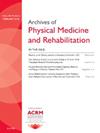完善退伍军人焦点小组协议的经验教训:为创伤性脑损伤患者调整大声思考和适应焦点小组[263]
IF 3.6
2区 医学
Q1 REHABILITATION
Archives of physical medicine and rehabilitation
Pub Date : 2025-04-01
DOI:10.1016/j.apmr.2025.01.027
引用次数: 0
摘要
为了改进涉及创伤性脑损伤(TBI)患者的研究,I-HEAL项目试图为那些可能有认知挑战的人完善焦点小组指南。使用了大声思考(Van Someren et al., 1994),但进行了调整,以便参与者能够最好地评估指南。该指南的目的是引出关于创伤性脑损伤退伍军人住院康复期间可接受做法的数据。设计使用了四个混合方法的定性会议:1个非结构化焦点小组(Brinkmann, 2014), 2个适应的大声思考,1个结构化焦点小组指导试点。设置是虚拟的(例如,Teams)。参与者是退伍军人医院的一个资深研究参与小组。7名参与者(4名TBI患者和3名护理人员)参加了第一和第四次会议。第二和第三次会议各包括2对夫妇的子样本(1名TBI患者和他们的照顾者)。干预措施第一次会议包括研究概述和参与者驱动的关于研究人员应该参与的实践的讨论。随后是改编的有声思考会议,根据反馈对指南进行实时修改。然后,做了一个试点来测试焦点小组指南的可用性。主要结果测量结果测量是在第一阶段给出的反馈(即对TBI退伍军人及其护理人员参与研究的一般建议),第二和第三阶段(即参与者提供的具体项目重新措辞)和第四阶段(即确定人们是否理解项目)。结果在会议1中,与会者的意见主要围绕两个主题:研究人员应提前向与会者提供材料;研究人员应该为参与者的认知留出足够的时间。在第2-3节中,参与者提出改写项目以减轻认知负担,例如建议使用直接和简短的句子。在第4次会议上,改进的指南得到了成功的试用,尽管由于需要认知处理时间和要求重定向和重复,它比其他焦点小组花费了更多的时间。这种新颖的、适应性强的有声思维程序比其他使用代码本组织和分析有声思维数据的程序更有优势,这些代码本的反馈可用于以后修改措施(例如,Ahmadi等人,2022;Kleyen et al., 2017)。使用目前的新方法,研究人员可以确保他们准确地理解反馈,参与者可以清楚地表达变化是否与他们的反馈有关。此外,为了允许参与者认知(Norman et al., 2019),使用有TBI参与者的焦点小组进行的研究可能会从分配50%的时间和减少成员(即4名参与者而不是6-8名参与者)中受益。本文章由计算机程序翻译,如有差异,请以英文原文为准。
Lessons from Refining a Focus Group Protocol with Veterans: Adapted Think-alouds and Accommodated Focus Groups for Persons with Traumatic Brain Injury 8263
Objectives
To improve research involving people with traumatic brain injury (TBI), Project I-HEAL sought to refine a focus group guide for those who may have cognitive challenges. Think-alouds (Van Someren et al., 1994) were used, but were adapted so participants could best evaluate the guide. The guide's purpose was to elicit data on acceptable practices during in-patient rehabilitation from veterans with TBI.
Design
Four mixed-method qualitative sessions were used: 1 unstructured focus group (Brinkmann, 2014), 2 adapted think-alouds, and 1 structured focus group guide pilot.
Setting
The setting was virtual (ie, Teams). Participants were a veteran research engagement group from a VA hospital.
Participants
Seven participants (4 persons with TBI and 3 caregivers) participated in the first and fourth session. The second and third sessions each comprised a subsample of 2 couples (1 person with TBI and their caregiver).
Interventions
The first session included study overview and participant-driven discussion about practices in which researchers should engage. This was followed by adapted think-aloud sessions in which real-time modifications to the guide based on feedback were made. Then, a pilot was done to test focus group guide usability.
Main Outcome Measures
Outcome measures were the feedback given in the first session (ie, general advice about veterans with TBI and their caregivers participating in research), the second and third sessions (ie, specific item rephrasing offered by participants), and the fourth session (ie, determinations of whether people understood items).
Results
In session 1, participants’ comments coalesced around 2 themes: researchers should provide materials to participants in advance; researchers should allow plenty of time for participants’ cognition. In sessions 2-3, participants offered rephrasing of items to reduce cognitive burden, such as by suggesting direct and shorter sentences. In session 4, the refined guide was piloted successfully, although it took more time than other focus groups due to cognitive processing time needed and requests for redirection and repetition.
Conclusions
This novel, adapted think-aloud procedure offers advantages over others that organize and analyze think-aloud data using codebooks with feedback being used to later revise measures (eg, Ahmadi et al., 2022; Kleyen et al., 2017). Using the present novel approach, researchers can ensure they are understanding feedback accurately and participants can articulate whether changes speak to their feedback. In addition, to allow for participant cognition (Norman et al., 2019), research using focus groups with participants with TBI may benefit from allotting 50% more time and including fewer members (ie, 4 participants rather than 6-8).
Disclosures
none.
求助全文
通过发布文献求助,成功后即可免费获取论文全文。
去求助
来源期刊
CiteScore
6.20
自引率
4.70%
发文量
495
审稿时长
38 days
期刊介绍:
The Archives of Physical Medicine and Rehabilitation publishes original, peer-reviewed research and clinical reports on important trends and developments in physical medicine and rehabilitation and related fields. This international journal brings researchers and clinicians authoritative information on the therapeutic utilization of physical, behavioral and pharmaceutical agents in providing comprehensive care for individuals with chronic illness and disabilities.
Archives began publication in 1920, publishes monthly, and is the official journal of the American Congress of Rehabilitation Medicine. Its papers are cited more often than any other rehabilitation journal.

 求助内容:
求助内容: 应助结果提醒方式:
应助结果提醒方式:


